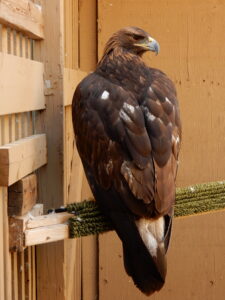Golden Eagle – Brienne
Name: Brienne “Brie” – Female 
Species: Golden Eagle
Liberty Arrival: December 2018/Juvenile
Injury/Condition: Electrocution
Brienne (Brie) was brought to Liberty Wildlife as an immature first-year eagle having severe wing injuries because of electrocution. She had both nerve and tendon damage, eliminating her ability to fly. Additionally, she was found to have aspergillosis (Valley Fever) which would require periodical blood work to monitor this disease throughout her life. She is now an eagle ambassador for Liberty.
Golden Eagle Facts
Description: The golden eagle is one of the largest, fastest, and most nimble raptors in North America. They have dark brown plumage crowned with gold on the back of the head and the nape. Juveniles will have clearly defined white patches at the base of the tail and the back of the wings.
Habitat: Golden eagles prefer to live in open and semi-open country featuring native vegetation across most of the Northern Hemisphere. They are found primarily in mountains up to 12,000 feet, canyonlands, rimrock terrain, and riverside cliffs and bluffs.
Range: Golden eagles are found throughout North America. From Alaska and Canada down south over the Continental US and into Baja California and parts of central Mexico. They are also found in Northern Europe and many parts of Northern Asia
Life span: The oldest known wild-banded golden eagle in North America was almost 31 years. The oldest known captive golden eagle lived to be 46 years old.
Prey: Golden eagles hunt mostly mammals such as rabbits, prairie dogs, ground squirrels, and hares. They will also eat birds such as pheasant, quail, Canada Geese, cranes, and great blue herons.
Nests: These eagles build their nests out of sticks and vegetation, locating them on a cliff or in a tree, or in human-made structures, such as windmills, observation towers, nesting platforms.
Babies: Golden eagles lay 1 – 3 eggs in a clutch. Babies hatch after 41 – 45 days. Youngsters fledge (learn to fly) around 45 – 81 days.
Águila Real – Brienne
Nombre: Brienne “Brie” – Hembra
Especie: Águila Real
Llegada a Liberty: Diciembre 2018/Joven
Herida/Condición: Electrocución
Trajeron a Brienne (Brie) a Liberty Wildlife cuando tenia un año con heridas graves a sus alas por haber sido electrocutada. Tenia daño hecho al los nervios y tendones, eliminado su capacidad de volar. Adicionalmente, se encontró que tenia aspergiollosis (Valley Fever) que requeriría análisis de sangre periódicamente para monitorear la enfermedad durante su vida. Ahora es embazadora de águilas para Liberty Wildlife
Datos del Águila Real
Descripción: El águila real es una de las aves de rapiña mas grandes, rápidos, y ágil en Norte América. Tienen plumaje de color café oscuro coronado con color oro en la parte de atrás de su cabeza y su nuca. Jóvenes tienen parches blancos en la base de su cola y la parte de atrás de sus alas.
Hábitat: El águila real prefiere vivir en paisajes abiertos o semiabiertos con vegetación nativo al hemisferio norteño. Se encuentran principalmente en las montañas de hasta 12,000 pies, cañones, terreno rocoso, y acantilados junto a los ríos.
Distribución: El águila real se puede encontrar a lo largo de Norte América. Desde Alaska y Canadá hasta el sur de Estados Unidos con Baja California y partes del centro de México. También se pueden encontrar en el Norte de Europa y varias partes del Norte de Asia.
Duración de vida: Una de las águilas reales salvajes conocidas en Norte América tenia casi 31 años. El mas viejo documentado que estaba en cautiverio vivió hasta los 46 años.
Presa: El águila real cazan principalmente mamíferos incluyendo conejos, perros de la pradera, y liebres. También comen pájaros como faisán, codorniz, gansos canadienses, grulla, y la gran garza azul.
Nidos: Estas águilas construyen sus nidos con palos y vegetación, colocándolas en acantilados, en un árbol, o estructuras hechas de humanos como los molinos, torres de observación, y plataformas para los nidos.
Crías: El águila real pone 1-3 huevos y sal del cascaron después de 41-45 días. Jóvenes aprenden a volar y se van después de 45-81 dias.


